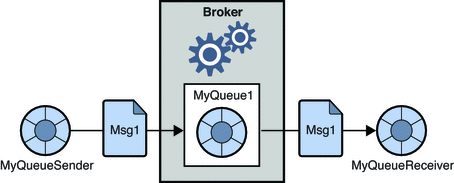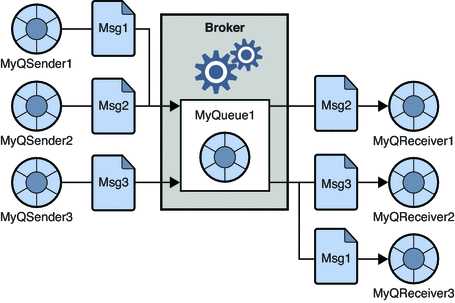Messaging Domains
Messaging middleware allows components and applications to communicate by producing and consuming messages. The JMS API defines two patterns or messaging domains that govern this communication: point-to-point messaging and publish/subscribe messaging. The JMS API is organized to support these patterns. The basic JMS objects: connections, sessions, producers, consumers, destinations, and messages are used to specify messaging behavior in both domains.
Point-To-Point Messaging
In the point-to-point domain, message producers are called senders and consumers are called receivers. They exchange messages by means of a destination called a queue: senders produce messages to a queue; receivers consume messages from a queue. What distinguishes point-to-point messaging is that a message can be consumed by only one consumer.
Figure 2–1 shows the simplest messaging operation in the point-to-point domain. MyQueueSender sends Msg1 to the queue destination MyQueue1. Then, MyQueueReceiver obtains the message from MyQueue1.
Figure 2–1 Simple Point-to-Point Messaging

Figure 2–2 shows a more complex picture of point-to-point messaging to illustrate the possibilities offered by this domain. Two senders, MyQSender1 and MyQSender2, use the same connection to send messages to MyQueue1. MyQSender3 uses an additional connection to send messages to MyQueue1. On the receiving side, MyQReceiver1 consumes messages from MyQueue1, and MyQReceiver2 and MyQReceiver3, share a connection in order to consume messages from MyQueue1.
Note –
Support for multiple-consumer queues is a Message Queue feature (the JMS specification defines messaging behavior in the case of only one consumer accessing a queue). When multiple consumers access a queue, the load-balancing among them takes into account each consumer’s capacity and message processing rate.
Figure 2–2 Complex Point-to-Point Messaging

This more complex picture exemplifies a number of additional points about point-to-point messaging.
-
More than one sender can produce and send messages to a queue. Senders can share a connection or use different connections, but they can all access the same queue.
-
More than one receiver can consume messages from a queue, but each message can be consumed by only one receiver. Thus Msg1, Msg2, and Msg3 are consumed by different receivers. (This is a Message Queue extension.)
-
Receivers can share a connection or use different connections, but they can all access the same queue. (This is a Message Queue extension.)
-
Senders and receivers have no timing dependencies: the receiver can consume a message whether or not it was running when the sender produced and sent the message.
-
Messages are placed in a queue in the order they are produced, but the order in which they are consumed depends on factors such as message expiration date, message priority, whether a selector is used in consuming messages, and the releative message processing rate of the consumers.
-
Senders and receivers can be added and deleted dynamically at runtime, thus allowing the messaging system to expand or contract as needed.
The point-to-point domain offers a number of advantages:
-
Messages destined for a queue are always retained, even if there are no receivers.
-
Java clients can use a queue browser object to inspect the contents of a queue. They can then consume messages based on the information gained from this inspection. That is, although the consumption model is normally FIFO (first in, first out), receivers can consume messages that are not at the head of the queue by using message selectors. Administrative clients can also use the queue browser to monitor the contents of a queue.
-
The fact that multiple receivers can consume messages from the same queue allows you to use load-balancing to scale message consumption if the order in which messages are received is not important.
Publish/Subscribe Messaging
In the publish/subscribe domain, message producers are called publishers and message consumers are called subscribers. They exchange messages by means of a destination called a topic: publishers produce messages to a topic; subscribers subscribe to a topic and consume messages from a topic.
Figure 2–3 shows a simple messaging operation in the publish/subscribe domain. MyTopicPublisher publishes Msg1 to the destination MyTopic. Then, MyTopicSubscriber1 and MyTopicSubscriber2 each receive a copy of Msg1 from MyTopic.
Figure 2–3 Simple Publish/Subscribe Messaging

While the publish/subscribe model does not require that there be more than one subscriber, two subscribers are shown in the figure to emphasize the fact that this domain allows you to broadcast messages. All subscribers to a topic get a copy of any message published to that topic.
Subscribers can be durable or non-durable. If a durable subscriber becomes inactive, the broker retains messages for it until the subscriber becomes active and consumes the messages. If a non-durable subscriber becomes inactive, the broker does not retain messages for it.
Figure 2–4 shows a more complex picture of publish/subscribe messaging to illustrate the possibilities offered by this domain. Several producers publish messages to the Topic1 destination. Several subscribers consume messages from the Topic1 destination. Unless, a subscriber is using a selector to filter messages, each subscriber gets all the messages published to the topic to which it is subscribed. In Figure 2–4, MyTSubscriber2 has filtered out Msg2.
Figure 2–4 Complex Publish/Subscribe Messaging

This more complex picture exemplifies a number of additional points about publish/subscribe messaging.
-
More than one publisher can publish messages to a topic. Publishers can share a connection or use different connections, but they can all access the same topic.
-
More than one subscriber can consume messages from a topic. Subscribers consume all messages published to a topic unless they use selectors to filter out messages or the messages expire before they are consumed.
-
Subscribers can share a connection or use different connections, but they can all access the same topic.
-
For durable subscribers, the broker retains messages for the subscribers while these subscribers are inactive.
-
Messages are placed in a topic in the order they are produced, but the order in which they are consumed depends on factors such as message expiration date, message priority, and whether a selector is used in consuming messages.
-
Publishers and subscribers have a timing dependency: a topic subscriber can consume only messages published after the subscriber has subscribed to the topic.
-
Publishers and subscribers can be added and deleted dynamically at runtime, thus allowing the messaging system to expand or contract as needed.
The main advantage of the publish/subscribe model is that it allows messages to be broadcast to multiple subscribers.
Domain-Specific and Unified APIs
The JMS API defines interfaces and classes that you can use to implement either of the point-to-point or the publish/subscribe domains. These are the domain-specific API’s shown in columns 2 and 3 of Table 2–1. The JMS API defines an additional unified domain, which allows you to program a generic messaging client. The behavior of such a client is determined by the type of the destination to which it produces messages and from which it consumes messages. If the destination is a queue, messaging will behave according to the point-to-point pattern; if the destination is a topic, messaging will behave according to the publish/subscribe pattern.
Table 2–1 JMS Programming Domains and Objects|
Base Type(Unified Domain) |
Point-to-Point Domain |
Publish/Subscribe Domain |
|---|---|---|
|
Destination (Queue or Topic) |
Queue |
Topic |
|
ConnectionFactory |
QueueConnectionFactory |
TopicConnectionFactory |
|
Connection |
QueueConnection |
TopicConnection |
|
Session |
QueueSession |
TopicSession |
|
MessageProducer |
QueueSender |
TopicPublisher |
|
MessageConsumer |
QueueReceiver |
TopicSubscriber |
The unified domain was introduced with JMS version 1.1. The domain-specific API also provides a clean programming interface that prevents certain types of programming errors: for example, creating a durable subscriber for a queue destination. However, the domain-specific APIs have the disadvantage that you cannot combine point-to-point and publish/subscribe operations in the same transaction or in the same session. If you need to do that, you should choose the unified domain API. See The Request-Reply Pattern for an example of combining the two domains.
- © 2010, Oracle Corporation and/or its affiliates
